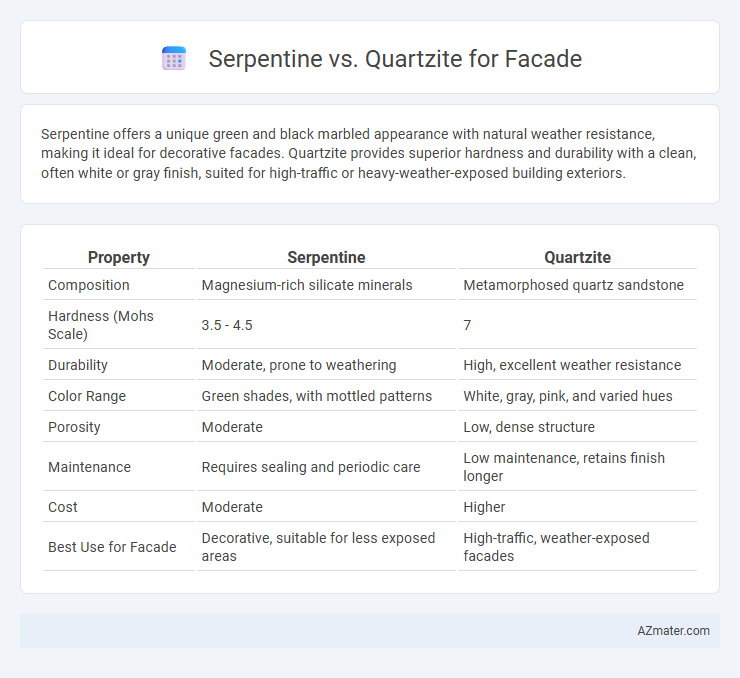Serpentine offers a unique green and black marbled appearance with natural weather resistance, making it ideal for decorative facades. Quartzite provides superior hardness and durability with a clean, often white or gray finish, suited for high-traffic or heavy-weather-exposed building exteriors.
Table of Comparison
| Property | Serpentine | Quartzite |
|---|---|---|
| Composition | Magnesium-rich silicate minerals | Metamorphosed quartz sandstone |
| Hardness (Mohs Scale) | 3.5 - 4.5 | 7 |
| Durability | Moderate, prone to weathering | High, excellent weather resistance |
| Color Range | Green shades, with mottled patterns | White, gray, pink, and varied hues |
| Porosity | Moderate | Low, dense structure |
| Maintenance | Requires sealing and periodic care | Low maintenance, retains finish longer |
| Cost | Moderate | Higher |
| Best Use for Facade | Decorative, suitable for less exposed areas | High-traffic, weather-exposed facades |
Introduction to Serpentine and Quartzite Facades
Serpentine facades offer a unique aesthetic characterized by deep green hues and a smooth, often fibrous texture, derived from metamorphic rock rich in magnesium and iron. Quartzite facades, recognized for their durability and resistance to weathering, feature a hard, granular surface resulting from quartz sandstone transformed under intense heat and pressure. Both materials provide distinct visual appeal and structural benefits, making them popular choices in architectural facade design.
Geological Origins and Composition
Serpentine originates from the metamorphism of ultramafic rocks, primarily composed of serpentinized olivine and pyroxene minerals, giving it a distinctive greenish hue. Quartzite forms through the metamorphism of pure quartz sandstone, resulting in an interlocking quartz grain structure with high silica content that enhances its hardness. The geological origin of serpentine contributes to its unique fibrous texture and variability in color, whereas quartzite's composition ensures superior durability and resistance to weathering for facade applications.
Visual Aesthetics: Color and Texture Differences
Serpentine offers rich, deep green hues with swirling, mottled patterns that create a bold, natural aesthetic for facades, while quartzite typically features lighter tones ranging from white and gray to soft pinks, with a more uniform, granular texture. The subtle shimmer of quartzite provides a sleek, refined appearance contrasting with serpentine's organic, variegated surface that enhances textural depth and visual complexity. Facades using serpentine appear more dramatic and dynamic, whereas quartzite facades exude elegance and subtle sophistication through consistent color and smooth texture.
Weather Resistance and Durability
Serpentine and quartzite both offer strong weather resistance for facades, but quartzite excels due to its higher hardness and resistance to abrasion, making it less prone to erosion and surface degradation over time. Serpentine, while more flexible and easier to carve, is more susceptible to weathering effects like acid rain and freeze-thaw cycles, which can weaken its structural integrity. Quartzite's superior durability and low porosity ensure long-lasting performance and minimal maintenance in harsh climates, making it the preferred choice for exterior cladding.
Maintenance Requirements and Longevity
Serpentine offers moderate maintenance due to its susceptibility to weathering and staining, requiring regular sealing to preserve its appearance on facades. Quartzite provides superior durability and resistance to harsh environmental conditions, resulting in lower maintenance needs and extended longevity for exterior cladding. Facades constructed with quartzite can withstand abrasive elements and retain structural integrity significantly longer than those with serpentine.
Thermal Performance and Energy Efficiency
Serpentine offers moderate thermal insulation due to its lower density and mineral composition, making it suitable for facades in mild climates where energy efficiency is a concern. Quartzite exhibits superior thermal mass and durability, effectively regulating indoor temperatures by absorbing and slowly releasing heat, which enhances energy efficiency in both hot and cold environments. Choosing quartzite for facades contributes to reduced heating and cooling loads, optimizing overall building energy performance compared to serpentine.
Cost Comparison: Installation and Material Prices
Serpentine typically offers a lower cost for both material and installation compared to quartzite, making it a budget-friendly choice for facade applications. Quartzite's higher price per square foot stems from its durability and aesthetic qualities, which also result in more complex, and thus costlier, installation requirements. Evaluating project budgets and desired facade longevity is essential when choosing between serpentine and quartzite.
Sustainability and Environmental Impact
Serpentine and quartzite differ significantly in sustainability and environmental impact for facade applications, with serpentine often sourced from local deposits reducing transportation emissions while quartzite's durability minimizes maintenance and replacement frequency, supporting long-term sustainability. Serpentine's lower embodied energy compared to quartzite makes it a preferable choice for eco-conscious construction projects aiming to reduce carbon footprint. Quartzite's resistance to weathering and chemical degradation decreases the need for protective coatings and repairs, enhancing its environmental performance over time.
Popular Applications in Modern Architecture
Serpentine and quartzite serve distinct roles in modern architectural facades, with serpentine prized for its deep green hues and weather resistance, making it ideal for creating striking, durable exterior cladding. Quartzite, a metamorphic rock known for its high strength and resistance to abrasion, is commonly used in commercial buildings and luxury residences for sleek, polished surface finishes that enhance both aesthetics and longevity. Both materials support sustainable design goals through natural stone's thermal mass properties, contributing to energy efficiency in facade systems.
Choosing the Right Stone: Key Considerations
Serpentine and quartzite differ significantly in durability and visual appeal, making the choice crucial for facades. Quartzite offers superior hardness and resistance to weathering, ideal for long-lasting exterior cladding, while serpentine provides unique green hues but is softer and may require more maintenance. Key considerations include climate conditions, structural support, aesthetic preferences, and budget constraints to ensure optimal performance and longevity.

Infographic: Serpentine vs Quartzite for Facade
 azmater.com
azmater.com